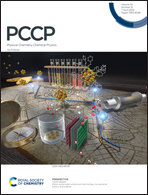On the effects of induced polarizability at the water–graphene interface via classical charge-on-spring models†
Abstract
Molecular models of the water–graphene interaction are essential to describe graphene in condensed phases. Different challenges are associated with the generation of these models, in particular π–π and dispersion interactions; thus quantum and classical models have been developed and due to the numerical efficiency of the latter, they have been extensively employed. In this work, we have systematically studied, via molecular dynamics, two polarizable graphene models, denominated CCCP and CCCPD, employing the charge-on-spring model of the GROMOS forcefield, both being compatible with the polarizable water models COS/G2 and COS/D2, respectively. These models were compared with non-polarizable graphene and SPC water models. We focused the study on the water–graphene interface in two distinct systems and under the influence of an electric field: one composed of graphene immersed in water and the other composed of graphene with a water droplet above it. In the former, the orientation of water close to the graphene layer is affected by polarizable graphene in comparison to non-polarizable graphene. This effect is emphasised when an electric field is applied. In the latter, carbon polarizability reduced water contact angles, but graphene retained its hydrophobicity and the computed angles are within the experimental data. Given the significant extra computational cost, the use of polarizable models instead of the traditional fixed-charged approach for the graphene–water interaction may be justified when polarizability effects are relevant, for example, when applying relatively strong fields or in very anisotropic systems, such as the vacuum–bulk interface, as these models are more responsive to such conditions.



 Please wait while we load your content...
Please wait while we load your content...